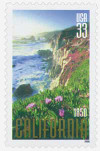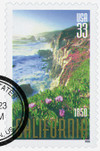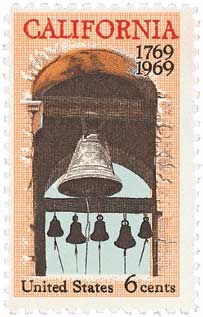
# 3438 - 2000 33c California Statehood
33¢ California Statehood
City: Sacramento, CA
Quantity: 53,000,000
Printed by: Avery Dennison
Printing Method: Photogravure
Perforations: Serpentine Die Cut 11
Color: Multicolored
California Admitted To The Union
Long before Europeans first explored California, it was inhabited by as many as 300,000 Indians. The Hupa and Pomo tribes lived in the north, the Maidu in the central region, and the Yuma in the south. Because of the region’s high mountains and vast deserts, these groups were isolated from one another, as well as from people farther east.
In 1542, Juan RodrÃguez Cabrillo, a Portuguese explorer employed by Spain, became the first European to sail along the coast of California. In 1579, Sir Francis Drake claimed the land for England. Afraid they were losing the region to the English, Spain sent more exploring parties to California. One of these explorers, Sebastián VizcaÃno, urged Spain to colonize the area before England had the chance.
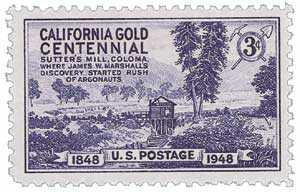
In 1769, Captain Gaspar de Portolá, governor of Baja California, founded a military fort at San Diego. That same year, also in San Diego, Father Junipero Serra established the first California Mission. Over the next 13 years, Father Serra founded eight more. By 1823, there were 21 missions in California, each within a day’s walk of the previous one.
Despite the large missionary presence, Spain did not have firm control over the region. In 1812, Russian fur traders from Alaska established Fort Ross on the northern California coast. Twelve years later, in response to the Monroe Doctrine – which was in part influenced by Russia’s expansion into the area – Russia agreed to limit its trapping to Alaska. However, the Russians did not leave Fort Ross until the early 1840s.
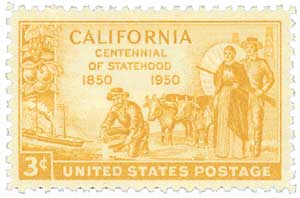
The missions were a powerful economic force. Many Indians who lived in these missions were forced to do hard labor for long hours. Also, as a number of Indians were exposed to new diseases, many became ill and died. Quite a number of people in California and Mexico wanted the missions shut down. As a result, the government began selling the missions in the 1830s. By 1846, nearly all the mission property had been sold.
In 1821, Mexico won its independence from Spain. A year later, California became a province of Mexico. The province was allowed to establish its own legislature and military force. But when Mexico began sending governors to the province in 1825, Californians began to resent the outside influence. Some citizens engaged Mexican troops in some minor conflicts. This continued resistance weakened Mexico’s control of the area.
In 1796, the Otter became the first American sailing vessel to reach California’s coast from the East. Many other ships soon began making this profitable voyage. In 1826, trapper Jedediah Strong Smith became the first American explorer to reach California by land. Many trappers and explorers soon followed in his footsteps. The first group of American settlers reached California in 1841. A schoolteacher, John Bidwell, and a wagon master and land speculator, John Bartleson, led these people. Wagon trains of settlers soon followed. So many American settlers poured into California that the United States offered to buy the land, but Mexico refused to sell.
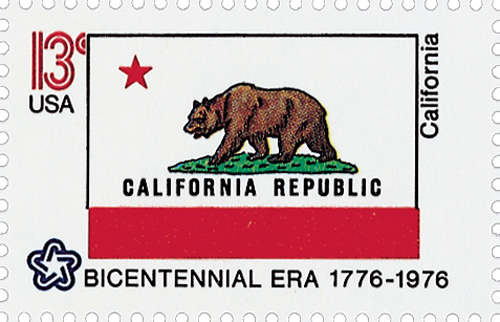
Military explorer John C. Frémont led surveying parties into California from 1844 to 1846. The Mexicans saw these expeditions as a threat. In March 1846, the Mexicans ordered Frémont to leave the area. Instead, he stood his ground, raising the US flag over Hawk’s Peak, located about 25 miles from Monterey. Frémont began building a fort, but when Mexican troops came to the area, Frémont withdrew. On May 13, 1846, the US and Mexico went to war.
In June 1846, California settlers, led by frontiersman Ezekiel Merritt, captured the Mexican fort at Sonoma. This fort served as Mexico’s headquarters for all of northern California . After capturing the fort, the settlers raised a homemade flag picturing a star, grizzly bear, and the words California Republic. This event became known as the Bear Flag Revolt.
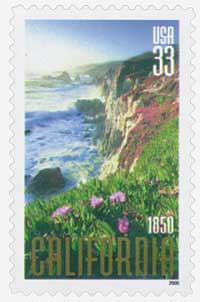
The Bear Flag Revolt was not a significant military action. Regular US armed forces completed the real military conquest of California. Frémont, Commodore Robert F. Stockton, and General Stephen W. Kearny led US troops. After the war, Mexico surrendered California in the Treaty of Guadalupe Hidalgo. California then became part of the US.
Gold was discovered in California in 1848 – just before the US and Mexico signed the peace treaty. The gold was discovered at Sutter’s Mill in the Sacramento Valley, on land granted to pioneer-trader John A. Sutter. Sutter hired carpenter James W. Marshall to construct a sawmill. It was Marshall who discovered the area’s first gold nuggets.
News of this discovery spread like wildfire, and thousands of miners rushed to establish claims. These miners became known as “Forty-Niners,” and they came from all over the world. Between 1848 and 1849, California’s population grew from about 15,000 to well over 100,000. The wealth generated by gold transformed small communities like San Francisco and Sacramento into flourishing towns.
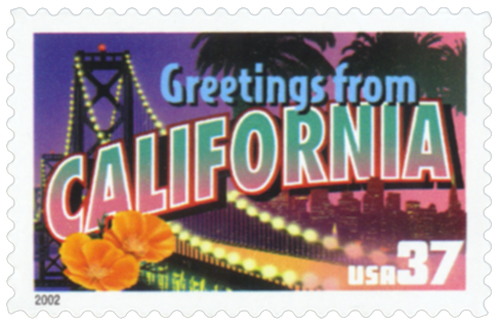
California was admitted to the Union on September 9, 1850, as a free state, as part of the Compromise of 1850. After the American Civil War ended in 1865, many Americans moved to the state, seeking high wages and low land prices. This movement was aided by the completion of the first transcontinental railroad in 1869, which linked the Eastern US with Sacramento, California. By 1870, the state’s population had grown to 560,000. A publicity campaign was staged during the 1880s to attract even more people. The campaign was so successful, it created a land boom, and the state’s economy flourished.
During the 1900s, California’s population and the economy continued to grow rapidly. When the Panama Canal was completed in 1914, shortening the sea route from the east, the growth was again accelerated. California was a major manufacturing and agricultural center during both World Wars. During the 1960s, the state expanded its educational system. It is believed California became the most populous state in 1963.
California’s population has grown rapidly since the 1970s, mainly due to an influx of immigration from other nations. These new immigrants have presented the state with many challenges in education and housing. During the 1980s, Santa Clara County became an international leader in high-technology electronics manufacturing, earning it the nickname “Silicon Valley.” California’s broad-based economy continues to grow.
33¢ California Statehood
City: Sacramento, CA
Quantity: 53,000,000
Printed by: Avery Dennison
Printing Method: Photogravure
Perforations: Serpentine Die Cut 11
Color: Multicolored
California Admitted To The Union
Long before Europeans first explored California, it was inhabited by as many as 300,000 Indians. The Hupa and Pomo tribes lived in the north, the Maidu in the central region, and the Yuma in the south. Because of the region’s high mountains and vast deserts, these groups were isolated from one another, as well as from people farther east.
In 1542, Juan RodrÃguez Cabrillo, a Portuguese explorer employed by Spain, became the first European to sail along the coast of California. In 1579, Sir Francis Drake claimed the land for England. Afraid they were losing the region to the English, Spain sent more exploring parties to California. One of these explorers, Sebastián VizcaÃno, urged Spain to colonize the area before England had the chance.

In 1769, Captain Gaspar de Portolá, governor of Baja California, founded a military fort at San Diego. That same year, also in San Diego, Father Junipero Serra established the first California Mission. Over the next 13 years, Father Serra founded eight more. By 1823, there were 21 missions in California, each within a day’s walk of the previous one.
Despite the large missionary presence, Spain did not have firm control over the region. In 1812, Russian fur traders from Alaska established Fort Ross on the northern California coast. Twelve years later, in response to the Monroe Doctrine – which was in part influenced by Russia’s expansion into the area – Russia agreed to limit its trapping to Alaska. However, the Russians did not leave Fort Ross until the early 1840s.

The missions were a powerful economic force. Many Indians who lived in these missions were forced to do hard labor for long hours. Also, as a number of Indians were exposed to new diseases, many became ill and died. Quite a number of people in California and Mexico wanted the missions shut down. As a result, the government began selling the missions in the 1830s. By 1846, nearly all the mission property had been sold.
In 1821, Mexico won its independence from Spain. A year later, California became a province of Mexico. The province was allowed to establish its own legislature and military force. But when Mexico began sending governors to the province in 1825, Californians began to resent the outside influence. Some citizens engaged Mexican troops in some minor conflicts. This continued resistance weakened Mexico’s control of the area.
In 1796, the Otter became the first American sailing vessel to reach California’s coast from the East. Many other ships soon began making this profitable voyage. In 1826, trapper Jedediah Strong Smith became the first American explorer to reach California by land. Many trappers and explorers soon followed in his footsteps. The first group of American settlers reached California in 1841. A schoolteacher, John Bidwell, and a wagon master and land speculator, John Bartleson, led these people. Wagon trains of settlers soon followed. So many American settlers poured into California that the United States offered to buy the land, but Mexico refused to sell.

Military explorer John C. Frémont led surveying parties into California from 1844 to 1846. The Mexicans saw these expeditions as a threat. In March 1846, the Mexicans ordered Frémont to leave the area. Instead, he stood his ground, raising the US flag over Hawk’s Peak, located about 25 miles from Monterey. Frémont began building a fort, but when Mexican troops came to the area, Frémont withdrew. On May 13, 1846, the US and Mexico went to war.
In June 1846, California settlers, led by frontiersman Ezekiel Merritt, captured the Mexican fort at Sonoma. This fort served as Mexico’s headquarters for all of northern California . After capturing the fort, the settlers raised a homemade flag picturing a star, grizzly bear, and the words California Republic. This event became known as the Bear Flag Revolt.

The Bear Flag Revolt was not a significant military action. Regular US armed forces completed the real military conquest of California. Frémont, Commodore Robert F. Stockton, and General Stephen W. Kearny led US troops. After the war, Mexico surrendered California in the Treaty of Guadalupe Hidalgo. California then became part of the US.
Gold was discovered in California in 1848 – just before the US and Mexico signed the peace treaty. The gold was discovered at Sutter’s Mill in the Sacramento Valley, on land granted to pioneer-trader John A. Sutter. Sutter hired carpenter James W. Marshall to construct a sawmill. It was Marshall who discovered the area’s first gold nuggets.
News of this discovery spread like wildfire, and thousands of miners rushed to establish claims. These miners became known as “Forty-Niners,” and they came from all over the world. Between 1848 and 1849, California’s population grew from about 15,000 to well over 100,000. The wealth generated by gold transformed small communities like San Francisco and Sacramento into flourishing towns.

California was admitted to the Union on September 9, 1850, as a free state, as part of the Compromise of 1850. After the American Civil War ended in 1865, many Americans moved to the state, seeking high wages and low land prices. This movement was aided by the completion of the first transcontinental railroad in 1869, which linked the Eastern US with Sacramento, California. By 1870, the state’s population had grown to 560,000. A publicity campaign was staged during the 1880s to attract even more people. The campaign was so successful, it created a land boom, and the state’s economy flourished.
During the 1900s, California’s population and the economy continued to grow rapidly. When the Panama Canal was completed in 1914, shortening the sea route from the east, the growth was again accelerated. California was a major manufacturing and agricultural center during both World Wars. During the 1960s, the state expanded its educational system. It is believed California became the most populous state in 1963.
California’s population has grown rapidly since the 1970s, mainly due to an influx of immigration from other nations. These new immigrants have presented the state with many challenges in education and housing. During the 1980s, Santa Clara County became an international leader in high-technology electronics manufacturing, earning it the nickname “Silicon Valley.” California’s broad-based economy continues to grow.









